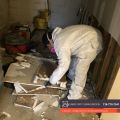Addressing Mold Inside Walls: Detecting Water Leaks and Navigating Remediation

Introduction:
Discovering mold within your walls can be a cause for concern, as it often indicates an underlying issue, such as water leaks. In this article, we will explore the potential risks associated with mold inside walls, discuss methods for finding water leaks concealed within the structure, and outline crucial steps for remediation. The insights provided draw from the expertise of Bay Area Mold Pros, emphasizing the importance of mold inspection and mold testing in ensuring a thorough and effective response.
Understanding the Risks:
- Hidden Mold Hazards:
Mold inside walls can proliferate undetected for extended periods, leading to potential health risks and structural damage. As mold thrives in damp environments, its presence often signifies an underlying moisture issue, such as a water leak within the walls.
- Health Implications:
Exposure to mold spores can result in respiratory issues, allergies, and other health concerns. The enclosed space within walls can facilitate the spread of mold spores through the air, making early detection and remediation imperative for occupant health.
Finding Water Leaks Inside Walls:
- Visual Inspection:
Conducting a visual inspection is the initial step in identifying water leaks. Look for visible signs of water damage, such as discoloration, peeling paint or wallpaper, and the presence of mold or mildew on surfaces. Stains or warping may indicate the source of a hidden leak.
- Use of Moisture Meters:
Moisture meters are valuable tools for detecting hidden moisture within walls. These devices measure the moisture content in building materials, helping identify areas with elevated moisture levels that may be conducive to mold growth.
- Infrared Thermography:
Infrared thermography utilizes thermal imaging to identify temperature variations in building materials. Water leaks often cause temperature differences, making this technology effective in locating concealed leaks within walls.
- Checking for Musty Odors:
Musty odors can be indicative of mold growth and hidden water leaks. If you notice a persistent musty smell in a particular area, it's crucial to investigate further to identify and address any underlying moisture issues.
Steps for Remediation:
When mold is suspected within walls, it is essential to engage the services of a professional mold inspector, such as those at Bay Area Mold Pros. Professional mold inspectors use advanced tools and techniques to assess the extent of mold growth, identify the type of mold present, and determine the root cause, including hidden water leaks.
- Addressing Water Leaks:
Remediation begins with addressing the root cause – the water leaks. Identifying and repairing the source of moisture is crucial for preventing the recurrence of mold growth. This may involve fixing plumbing issues, repairing roof leaks, or addressing problems with the building envelope.
- Mold Removal:
Mold removal should be conducted by trained professionals to ensure thorough and safe remediation. Depending on the extent of the infestation, removal methods may include scrubbing surfaces, applying antimicrobial agents, and using advanced techniques to address hidden mold within walls.
- Ventilation and Drying:
Adequate ventilation and drying are essential components of the remediation process. Ensuring proper airflow and reducing humidity levels help prevent the reoccurrence of mold. Dehumidifiers and fans may be employed to expedite the drying process.
- Post-Remediation Testing:
After remediation, it is crucial to conduct post-remediation testing to verify the effectiveness of the process. Professional mold testing can confirm that the mold has been successfully removed, and the indoor environment is safe for occupants.
Preventive Measures and Ongoing Maintenance:
- Regular Inspections:
Implementing regular inspections, both visual and professional, is crucial for early detection of water leaks and mold growth. Proactive measures help address issues before they escalate.
- Maintaining Proper Ventilation:
Ensuring proper ventilation throughout the building helps regulate humidity levels, reducing the conditions favorable for mold growth. Proper ventilation also aids in preventing the accumulation of moisture within walls.
- Prompt Repairs:
Addressing any signs of water damage promptly, whether it's a leaky roof or plumbing issue, is vital for preventing mold growth. Timely repairs minimize the risk of prolonged exposure to moisture.
Conclusion:
Mold inside walls poses potential health risks and structural concerns, necessitating a comprehensive approach to detection and remediation. Bay Area Mold Pros emphasizes the importance of professional mold inspection and testing to accurately assess the extent of mold growth, identify hidden water leaks, and implement effective remediation strategies. By combining thorough inspections, prompt remediation, and ongoing preventive measures, occupants can enjoy a healthier and mold-free indoor environment.





